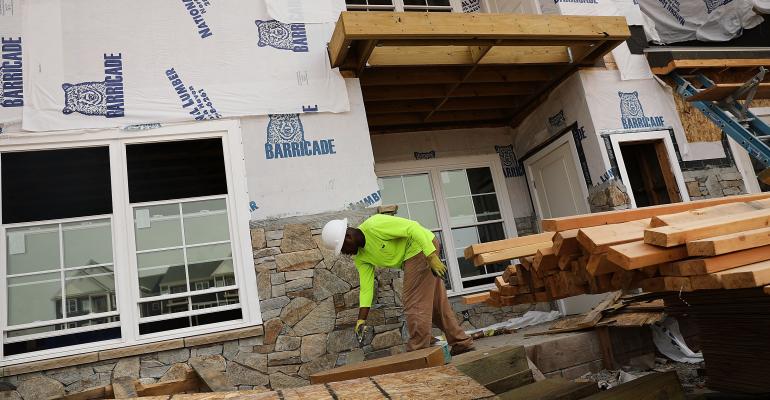Even after a flood of new construction, it is still possible to get a construction loan to build new apartment projects.
“Everything is financeable at some level and cost,” says Mark Fisher, senior vice president for CBRE Capital Markets.
Developers will open more new rental apartments in 2017 than during any year since 2007. All of this new construction has made many lenders cautious as they consider loans on new apartment projects. In addition, banks are still contending with regulations that have taken effect over the past year that cut into their ability to lend. As a result, construction loans are often smaller compared to the cost of development, and lenders have become more cautious when they consider loans on certain types of projects.
“Non-recourse construction loans over 50 percent loan-to-cost and any type of conventional condo construction loan are in scarce supply,” says CBRE’s Fisher.
Banks keep lending
Nevertheless, banks continue to make new construction loans faster than borrowers pay off old ones as they finish projects under development. Bank lenders increased their exposure to real estate construction loans by $30.4 billion, or 10.31 percent, in the last 12 months compared to the year before, according to data from research firm CoStar. This rate of growth is only slightly below the rate of the past few years’. On a three-year basis, construction exposure has increased by $102.2 billion, or 45.75 percent, compared to the prior three-year period.
“Keep in mind that growth is off a period of extraordinarily low activity,” says Justin Bakst, director of capital markets at CoStar Portfolio Strategy.
Loan terms
However, borrowing continues to get more expensive for apartment developers.
Interest rates for construction loans are higher than a year ago—though not as high as experts feared.
Short-term interest rates of all kinds have gone up as central banks like the U.S. Federal Reserve raised their benchmark interest rates. The Fed has raised its rates several times in the past 12 month, even if the increases didn’t happen as quickly and weren’t as high as anticipated. “There is an expectation that the Federal Reserve will raise rates again in December,” says Dave Borsos, vice president of capital markets for the National Multifamily Housing Council (NMHC), though the Fed may also delay the rate hike.
In addition, banks now often charge a spread of more than 300 basis points over LIBOR, up from spread of 175 to 200 basis points two years ago.
Meanwhile, the amount of money banks are willing to lend continues to shrink relative to the cost of developing a property. As a result, developers need to bring more equity to their construction projects, either by contributing their own money or by bringing in equity partners.
Many banks once offered construction loans that covered up to 70 percent of the cost of development. Today, they only offer loans that cover 55 percent to 65 percent of the cost.
Other lenders offer construction financing
Some debt funds can help developers fill the gap in their financing created by these smaller loans.
“There is a broad other universe of debt funds and other private lenders that are stepping in and providing the higher leverage portion of a financing,” says Tal Bar-Or, senior managing director for Meridian Capital Group, a commercial mortgage provider. With help from these lenders, apartment developers can borrow up to 85 percent of the cost of development, depending on underwriting.
A few regional banks are also taking the opportunity to make construction loans, sometimes underwriting projects far from the region where they typically do business. The Bank of the Ozarks, for example, has financed the construction of a string of condominium towers in New York City in recent years.
A few life companies, including Pacific Life, have also stepped up to make construction loans on new apartment buildings. In some cases, life companies offer “all-in-one” financing, in which construction and permanent financing are packaged together into a single loan.
“Life companies have and continue to make lower loan-to-cost construction loans on a selective basis,” says CBRE’s Fisher. However, these loans are still a small part of the construction finance business. “There are only a few players in that arena and even less takers.”
Demand for rentals
Demand for apartments continues to be strong, even taking into account all the new construction that has happened in recent years. “There is still very strong ongoing demand that is not being filled,” says NMHC’s Borsos. “We need roughly 300,000 new apartments a year. This year we are over that average, but not dramatically higher.”
However, lenders are looking carefully at the particular markets where they consider lending. For example, in Denver, Seattle or New York City they might be careful to consider how a proposed project will fit into its submarket among the other projects that have recently opened or are opening around it.
Multifamily construction starts have dropped in 2017, but that’s following a strong year in 2016. Projects that broke ground in 2015 and 2016 hit the market in late 2016 or are coming on-line now. There has been a 20.4 percent increase in completions in 2017, the most since 2007. “Developers may be sitting on the sidelines waiting to gauge the market absorption,” says CoStar’s Bakst.

